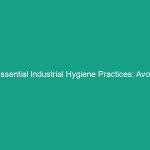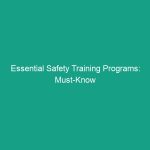Must-Know Vehicle Inspection Guidelines to Ensure Safety on the Road
Good morning team! Today, we’re going to talk about something that is crucial not only for our Safety but also for the well-being of everyone on the road: vehicle inspection guidelines. Understanding these guidelines can significantly reduce the risks of accidents and ensure that our vehicles are safe to operate.
Understanding Vehicle Inspection Guidelines
Vehicle inspection guidelines refer to the Procedures and checks necessary to ensure that a vehicle is in safe working condition. This is vital in our line of work, as a malfunctioning vehicle can lead to serious accidents, injuries, or even fatalities. Regular inspections can help identify potential problems before they escalate into critical issues, impacting our daily operations and safety.
Many employees may think that vehicle inspections are just a formality or that they can skip them if the vehicle seems to be working fine. However, this misconception can lead to devastating consequences. Remember, a few minutes spent on inspection can save lives!
Key Hazards, Risks, and Safety Considerations
When it comes to vehicle inspections, there are several Hazards and risks associated with neglecting this critical task:
- Mechanical Failures: Issues such as brake failure or tire blowouts can occur without warning.
- Visibility Problems: Malfunctioning lights or mirrors can hinder your ability to see or be seen by other drivers.
- Fluid Leaks: Oil, coolant, or brake fluid leaks can lead to engine failure or loss of braking power.
The consequences of ignoring these safety protocols can be severe. For instance, a simple brake failure can cause a collision, putting your life and the lives of others at risk. By being proactive with vehicle inspections, we can prevent these issues from arising.
Best Practices, Procedures, & Actionable Advice
To ensure we adhere to vehicle inspection guidelines effectively, here are some Best Practices:
1. Daily Pre-Trip Inspections
Before getting on the road, conduct a thorough inspection of your vehicle:
- Check Fluid Levels: Ensure oil, coolant, brake fluid, and windshield washer fluid are at appropriate levels.
- Inspect Tires: Check for proper inflation and tread depth. Look for signs of wear or damage.
- Examine Lights: Ensure all headlights, taillights, brake lights, and turn signals are functioning.
- Test Brakes: Make sure the brake pedal feels firm and responsive.
- Check Wipers: Ensure wiper blades are in good condition and that the windshield is clean.
2. Regular Maintenance Checks
In addition to daily inspections, schedule regular maintenance checks with a qualified mechanic. This should include:
- Oil changes
- Tire rotations
- Brake inspections
- Battery checks
Document all maintenance performed on the vehicle to keep a record of its condition.
3. Utilize a Vehicle Inspection Checklist
Using a checklist can help ensure that you do not miss any critical components during your inspection. Here’s a simple checklist:
- Exterior condition
- Mirrors and windows
- Interior controls and instruments
- Safety equipment (first aid kit, fire extinguisher)
4. Case Study: Lessons from Real-World Incidents
Consider the case of a delivery driver who skipped a routine inspection. The driver experienced brake failure due to worn-out brake pads, resulting in a collision. Fortunately, no one was seriously injured, but the incident caused significant vehicle damage and downtime. This serves as a powerful reminder of the importance of adhering to vehicle inspection guidelines.
Regulations, Standards, and Compliance
It’s essential to be aware of relevant safety Regulations. OSHA and DOT provide guidelines that outline the necessary vehicle safety Standards. Compliance with these regulations is not just about avoiding fines; it’s about protecting our team and the public. Regular inspections ensure that our fleet meets these standards, which ultimately enhances our operational efficiency and safety.
Employee Engagement & Discussion
Now that we understand the importance of vehicle inspections, let’s open the floor for discussion. What challenges have you encountered when performing vehicle inspections? Are there any specific areas that you feel need more attention? Your input is invaluable in making our workplace safer!
Conclusion & Key Takeaways
To wrap up, remember that vehicle inspection guidelines are vital for ensuring safety on the road. Regular inspections can prevent mechanical failures, enhance visibility, and keep our vehicles in optimal condition. By adhering to these guidelines, we not only comply with regulations but also safeguard our lives and those of others.
Thank you for your attention and commitment to maintaining safety standards. Let’s prioritize vehicle inspections and continue to make safety our top priority!


